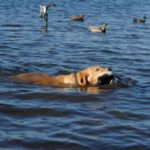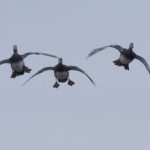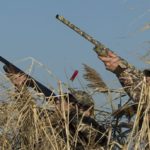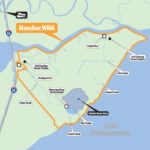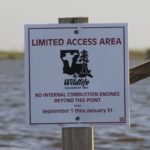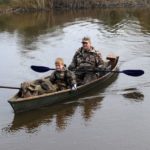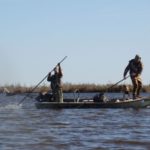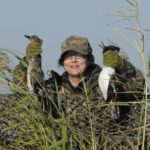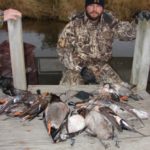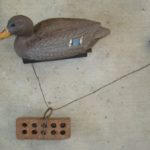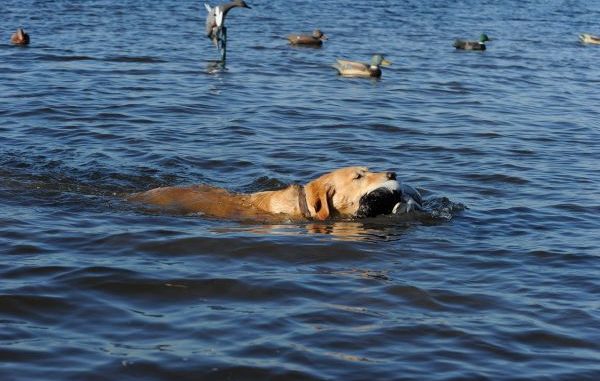
Manchac WMA’s limited access area might make it harder to reach the best duck-hunting areas, but once you get there the hunting is better — if you know the secret to success.
I knew this would probably be my last Louisiana duck hunt.
The Sirens Ulysses had to deal with had nothing on the Call of the Grandchildren: The wife was putting on serious pressure to move to Colorado.
To make things worse, it was not even going to be a pretty hunting day. Temperatures were predicted to rise into the 70s. But off I went anyway.
The location of this final Bayou State hunt was the limited access area on Manchac Wildlife Management Area in St. John Parish about 11 miles southeast of Ponchatoula.
This property was a mature cypress swamp 200 years ago. By 1940, however, most of the large timber had been harvested, leaving a network of logging runs.
Manchac has been a popular public waterfowl hunting area since it was acquired by the Louisiana Department of Wildlife and Fisheries back in 1975. When I first went to work for the LDWF in 1979, I was hired to be the Manchac technician.
At the last minute, then Wildlife Division chief Joe Herring asked if I would consider going to the now-extinct Bohemia WMA instead, which I did.
I still worked Manchac on opening weekends, and have hunted the area for over 30 years. At the time of my retirement, I was the biologist over the area.
While there are many good locations around the WMA, most waterfowl hunting takes place on an 800-acre body of open freshwater known locally as “the Prairie” next to the Lake Pontchartrain shore.
Back in the 70s everyone parked their motorboats at the end of the Galva Canal, and then paddled pirogues down the shallow boat run to the Prairie.
Things changed with the advent of Go-Devils and pro-drive boats, which made it possible to run all the way back to the Prairie — and most serious hunters switched over.
Waterfowl hunting in the early years was tremendous. Birds were plentiful and bag limits came easy.
But in the last decade, hunter success seems to have fallen off a bit. Waterfowl Study Leader Larry Reynolds said he suspects the decline might have resulted from a number of factors.
The warm weather over the last several years has certainly not helped any. Saltwater intrusion from Lake Pontchartrain and mud stirred up by powerboats might be negatively impacting the aquatic vegetation favorable to waterfowl.
Lastly, boating activities on the relatively small Prairie may be pressuring waterfowl.
While conducting bag checks year after year, I routinely watched hunters get bored around 8 a.m. and start making loops around the Prairie in their Go-Devils. These same hunters would come out and complain there were no birds on the Prairie.
When pro-drive motors were introduced it only got worse because these motors were so much faster.
Back in the 90s, I paddled out to the Prairie the day before the season and observed well over 2,000 gadwalls. I bag-checked waterfowl hunters the next day, and only one gadwall come out.
When the pressure hit the Prairie, the gadwall left.
In 2011, the Department elected to make 536 acres (6.4 percent of the entire WMA) on the Prairie a limited access area, where operation of boats with internal combustion engines is prohibited from Sept. 1 thru Jan. 31.
Larry Reynolds said the purpose of the change was to minimize disturbance of waterfowl, protect available habitat and provide a better hunting experience for waterfowl hunters.
Hunters may still push-pole their boats into the area, and the use of electric trolling motors is allowed.
And approximately a quarter of the Prairie is still open to use with motorized vessels.
I hunted the area opening day last season and, surprisingly, I saw only two other pirogues. Most people were poling mud-boats into the LAA zone to hunt.
The most frequent complaint heard from these hunters was the difficulty in chasing down cripples. Hunters with retrievers and/or pirogues had much less problem.
But area biologist Christian Winslow said the LAA, which has been in effect for two seasons, seems to be working well.
The number of ducks killed per hunter on opening weekend during the past two seasons was the highest in 10 years.
In 2011-12, hunters took 2.52 ducks/hunter effort on opening weekend. In 2012-13, hunters took 3.14 ducks/hunter effort.
The four most-common ducks taken were gadwall (63 percent), lesser scaup (21 percent), mallards (3 percent) and redheads (3 percent).
Hunters on Manchac are required to fill out daily self clearing permits. This allows biologists to get an idea of hunter use and success for the entire season. The data indicate 1,173 hunter efforts the year prior to the LAA; the first year of the LAA, the number fell to 814. The second year hunters seem to adapt to the change, and efforts rose to 933.
Surveys run to determine how well hunters were accepting the new limited access area indicate support for these areas is increasing.
In 2011-12, 62 percent of hunters surveyed said they strongly approved, approved or had no opinion of the change. Another 38 percent opposed or strongly opposed the LLA.
In 2012-13, 85 percent of those surveyed strongly approved, approved or had no opinion, while 15 percent opposed or strongly opposed.
As I paddled around during the season, I also asked hunters what they thought about the LAA. One hunter who had push-poled a Go-Devil halfway across the Prairie summed it up best when he said, “It sucks. But I love it.”
Plainly speaking, it made hunting access tougher, but it also made hunting better.
Over the years, the shoreline between Lake Pontchartrain and the Manchac Prairie has been steadily eroding. And influxes of salt water into the WMA from Fourth Canal negatively impacted the submerged vegetation waterfowl prefer.
A project initiated several years ago by the LDWF and the Army Corps of Engineers should help: A rock breakwater was built offshore and now dredged spoil is being pumping into the gap. The project should be completed by 2014, and will create 100 acres of protecting lake shore.
Just prior to my last hunt, I called Winslow to see how hunting was going. He told me many of the hunters the prior week had struck out completely, and those having success were getting only a bird or two.
This did not bolster my confidence a great deal, but I never claimed to be smart. I went hunting.
Most folks launch at the public landing located at Highway 51 and North Pass. It takes about 30 minutes to reach the check station on the Galva Canal, and then another 15 minutes to reach the end of the Galva, where I parked the motorboat.
After a brisk, 20-minute pirogue paddle down the boat run I arrived on the Prairie — well before daylight. It should have come as no surprise: With only two other boats on the entire area, one hunter had beaten me in to the location I had wanted to hunt.
So, I paddled on down toward the north end of the Prairie and found an old reed blind in the open water. I put out 23 decoys on the lee side of the blind. Birds like to land into the wind, but can be hesitant about landing in the decoys so I made sure the decoys were close enough to shoot past.
The two other hunter groups did not do much. Between them, they fired only a dozen times and left early.
I didn’t see a bird for the first 30 minutes of shooting time — and none before shooting time.
Then, much to my pleasant surprise, birds started coming in every 20 minutes or so. Not many, but enough.
Most were singles. I shot better than I had on previous hunts; still not good, but better.
It took the second or third shot to finish each bird off, and I had to chase one cripple 100 yards and shoot at it three more times.
But I got it.
Oh, by the by, wading is not real practical on Manchac. The mud doesn’t seem to have a bottom. On a previous hunt I shot a bird down 70 yards away on “land.” I had to cross two or three drains to get to it. On the last, I made a misstep and sank up to my waist in the mud.
I was seriously stuck and couldn‘t get out. I had to unload the shotgun and use it for a crutch. When I finally got free, the barrel and receiver were filled with mud.
I took the gun apart, rinsed it out with muddy water and kept on hunting. That is what they make the Remington 870 shotgun for.
Try that with a Beretta or Benelli and let me know how it comes out.
Even in January it is often necessary to pick your ducks up promptly. If not, the Manchac Retrievers (known in most parts as alligators) might beat you to them. I had a nice 8-footer sitting just outside my decoys this entire hunt.
Gunfire appeared to not bother it at all.
Anyway, it was a dead-calm day, providing little movement of the decoys. That doesn’t look very natural to an overhead flight, so I pulled a trick we used in the old days, back before the advent of Robo-Ducks.
I ran a line out to one of my decoys anchored through a brick: When a duck flew by, I would yank the line, making the decoy bob up and down to create ripples in the decoys.
On one occasion I pulled on the string and had a gadwall land 70 yards from the decoys. I kept jiggling my decoy, and darned if the bird did not fly right on in to me.
That was bird No. 3.
A friend of mine, Tommy Prickett, told me he uses a similar ploy. He sticks a paddle down in the mud with just the tip sticking out of the water. When birds come by he jerks the string and makes waves in the decoys.
It may not be high-tech, but it works.
Over 45 years of pursuing our web-footed friends, I have learned it is not crucial to blow a call well to kill ducks. Which is good, because I have never been very efficient with a call.
I have a friend, Mark Jarreau, who does happen to be a very good caller, so I went to him for a lesson. We went on an imaginary duck hunt, where I would narrate what the ducks were doing, and see how Mark responded. I then gave it a try myself.
“It needs work,” he responded. “It needs lots of work.”
This did not instill a great deal of confidence in my calling. So, I refrained from calling unless I had nothing to lose. I usually camouflage well with net and reeds, and depend on my decoy spread to do the job.
On this day, I managed to kill five birds without calling once.
At 9:30, I spotted a pair of summer mallards off in the distance, so I figured, “What the heck,” I gave a “hi-ball” on my Yentzen duck call.
I was shocked when they turned and came right on in and made a lightning run over the decoys.
This final bird was the only one I dropped with a single shot. Which just goes to show, accidents do happen. Obviously, this last bird was not awfully bright; it came to my calling. It probably would have come to a crow call.
So, I actually got a limit: four grey ducks, one summer mallard and the real prize — one dos gris. In English, that is four gadwalls, one mottled duck and one of the elusive and much-sought-after lesser scaup.
There really weren’t many birds flying on this particular day, but I still got my limit. Had anyone been with me, we probably would have taken seven or eight birds — or, more likely, we both would have just shot the same birds.
The important point here is, persistence and patience pays off. It doesn’t matter if you are deer, turkey or duck hunting: The more time you spend hunting, the “luckier” you will be. Statistically speaking, chances of bagging a critter is significantly lower if you are at the house or having lunch in the truck.
On the paddle out, I saw three bald eagles. It was a fine ending for my last hunt.
